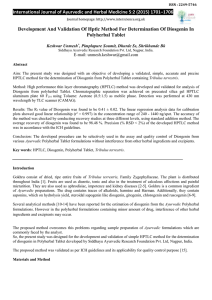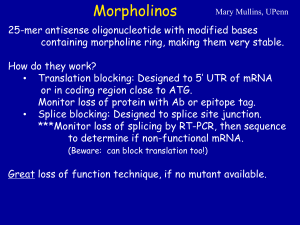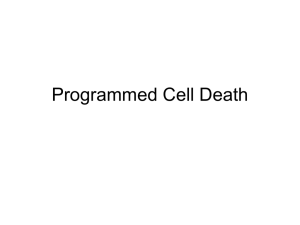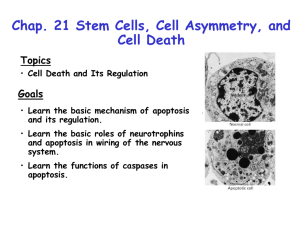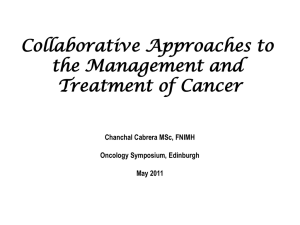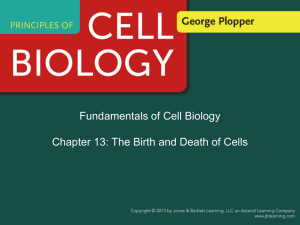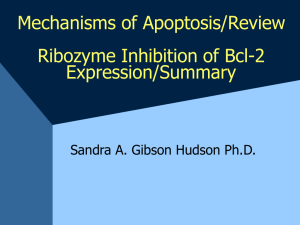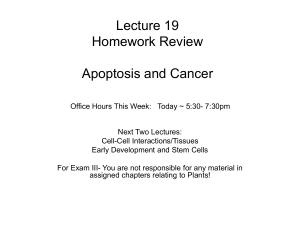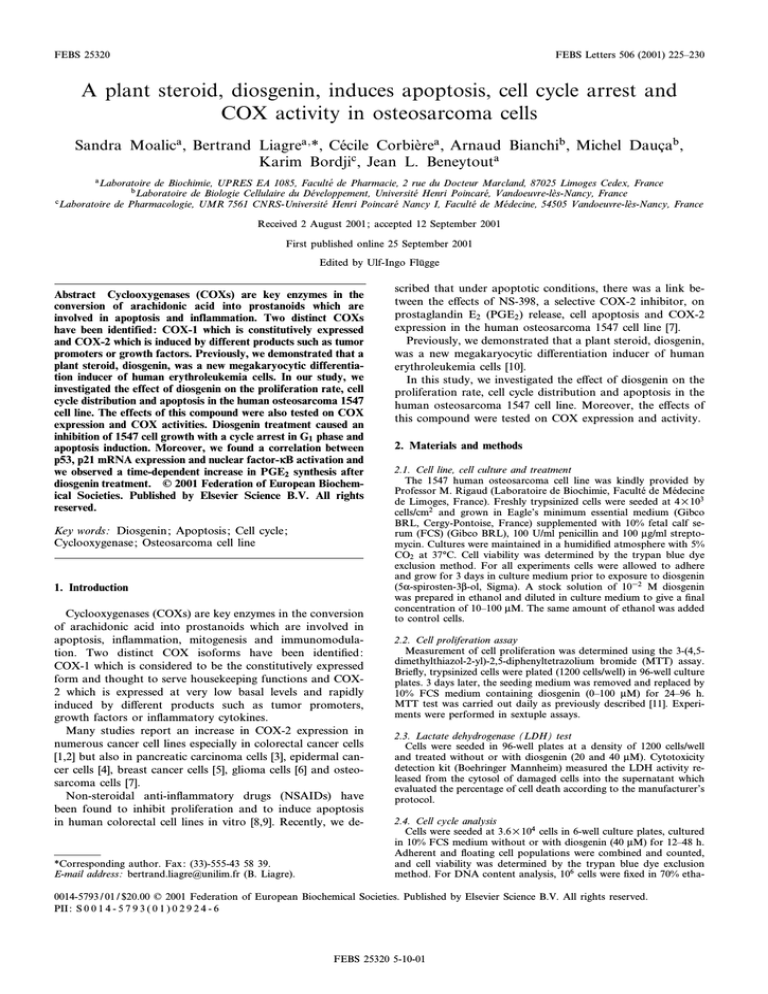
FEBS 25320
FEBS Letters 506 (2001) 225^230
A plant steroid, diosgenin, induces apoptosis, cell cycle arrest and
COX activity in osteosarcoma cells
Sandra Moalica , Bertrand Liagrea; *, Ce¨cile Corbie©rea , Arnaud Bianchib , Michel Dauc°ab ,
Karim Bordjic , Jean L. Beneytouta
a
Laboratoire de Biochimie, UPRES EA 1085, Faculte¨ de Pharmacie, 2 rue du Docteur Marcland, 87025 Limoges Cedex, France
b
Laboratoire de Biologie Cellulaire du De¨veloppement, Universite¨ Henri Poincare¨, Vandoeuvre-le©s-Nancy, France
c
Laboratoire de Pharmacologie, UMR 7561 CNRS-Universite¨ Henri Poincare¨ Nancy I, Faculte¨ de Me¨decine, 54505 Vandoeuvre-le©s-Nancy, France
Received 2 August 2001; accepted 12 September 2001
First published online 25 September 2001
Edited by Ulf-Ingo Flu«gge
Abstract Cyclooxygenases (COXs) are key enzymes in the
conversion of arachidonic acid into prostanoids which are
involved in apoptosis and inflammation. Two distinct COXs
have been identified: COX-1 which is constitutively expressed
and COX-2 which is induced by different products such as tumor
promoters or growth factors. Previously, we demonstrated that a
plant steroid, diosgenin, was a new megakaryocytic differentiation inducer of human erythroleukemia cells. In our study, we
investigated the effect of diosgenin on the proliferation rate, cell
cycle distribution and apoptosis in the human osteosarcoma 1547
cell line. The effects of this compound were also tested on COX
expression and COX activities. Diosgenin treatment caused an
inhibition of 1547 cell growth with a cycle arrest in G1 phase and
apoptosis induction. Moreover, we found a correlation between
p53, p21 mRNA expression and nuclear factor-U
UB activation and
we observed a time-dependent increase in PGE2 synthesis after
diosgenin treatment. ß 2001 Federation of European Biochemical Societies. Published by Elsevier Science B.V. All rights
reserved.
Key words: Diosgenin; Apoptosis ; Cell cycle;
Cyclooxygenase; Osteosarcoma cell line
1. Introduction
Cyclooxygenases (COXs) are key enzymes in the conversion
of arachidonic acid into prostanoids which are involved in
apoptosis, in£ammation, mitogenesis and immunomodulation. Two distinct COX isoforms have been identi¢ed:
COX-1 which is considered to be the constitutively expressed
form and thought to serve housekeeping functions and COX2 which is expressed at very low basal levels and rapidly
induced by di¡erent products such as tumor promoters,
growth factors or in£ammatory cytokines.
Many studies report an increase in COX-2 expression in
numerous cancer cell lines especially in colorectal cancer cells
[1,2] but also in pancreatic carcinoma cells [3], epidermal cancer cells [4], breast cancer cells [5], glioma cells [6] and osteosarcoma cells [7].
Non-steroidal anti-in£ammatory drugs (NSAIDs) have
been found to inhibit proliferation and to induce apoptosis
in human colorectal cell lines in vitro [8,9]. Recently, we de-
*Corresponding author. Fax: (33)-555-43 58 39.
E-mail address: bertrand.liagre@unilim.fr (B. Liagre).
scribed that under apoptotic conditions, there was a link between the e¡ects of NS-398, a selective COX-2 inhibitor, on
prostaglandin E2 (PGE2 ) release, cell apoptosis and COX-2
expression in the human osteosarcoma 1547 cell line [7].
Previously, we demonstrated that a plant steroid, diosgenin,
was a new megakaryocytic di¡erentiation inducer of human
erythroleukemia cells [10].
In this study, we investigated the e¡ect of diosgenin on the
proliferation rate, cell cycle distribution and apoptosis in the
human osteosarcoma 1547 cell line. Moreover, the e¡ects of
this compound were tested on COX expression and activity.
2. Materials and methods
2.1. Cell line, cell culture and treatment
The 1547 human osteosarcoma cell line was kindly provided by
Professor M. Rigaud (Laboratoire de Biochimie, Faculte¨ de Me¨decine
de Limoges, France). Freshly trypsinized cells were seeded at 4U103
cells/cm2 and grown in Eagle's minimum essential medium (Gibco
BRL, Cergy-Pontoise, France) supplemented with 10% fetal calf serum (FCS) (Gibco BRL), 100 U/ml penicillin and 100 Wg/ml streptomycin. Cultures were maintained in a humidi¢ed atmosphere with 5%
CO2 at 37³C. Cell viability was determined by the trypan blue dye
exclusion method. For all experiments cells were allowed to adhere
and grow for 3 days in culture medium prior to exposure to diosgenin
(5K-spirosten-3L-ol, Sigma). A stock solution of 1032 M diosgenin
was prepared in ethanol and diluted in culture medium to give a ¢nal
concentration of 10^100 WM. The same amount of ethanol was added
to control cells.
2.2. Cell proliferation assay
Measurement of cell proliferation was determined using the 3-(4,5dimethylthiazol-2-yl)-2,5-diphenyltetrazolium bromide (MTT) assay.
Brie£y, trypsinized cells were plated (1200 cells/well) in 96-well culture
plates. 3 days later, the seeding medium was removed and replaced by
10% FCS medium containing diosgenin (0^100 WM) for 24^96 h.
MTT test was carried out daily as previously described [11]. Experiments were performed in sextuple assays.
2.3. Lactate dehydrogenase (LDH) test
Cells were seeded in 96-well plates at a density of 1200 cells/well
and treated without or with diosgenin (20 and 40 WM). Cytotoxicity
detection kit (Boehringer Mannheim) measured the LDH activity released from the cytosol of damaged cells into the supernatant which
evaluated the percentage of cell death according to the manufacturer's
protocol.
2.4. Cell cycle analysis
Cells were seeded at 3.6U104 cells in 6-well culture plates, cultured
in 10% FCS medium without or with diosgenin (40 WM) for 12^48 h.
Adherent and £oating cell populations were combined and counted,
and cell viability was determined by the trypan blue dye exclusion
method. For DNA content analysis, 106 cells were ¢xed in 70% etha-
0014-5793 / 01 / $20.00 ß 2001 Federation of European Biochemical Societies. Published by Elsevier Science B.V. All rights reserved.
PII: S 0 0 1 4 - 5 7 9 3 ( 0 1 ) 0 2 9 2 4 - 6
FEBS 25320 5-10-01
226
S. Moalic et al./FEBS Letters 506 (2001) 225^230
nol (in phosphate-bu¡ered saline (PBS)), washed in PBS and stained
with propidium iodide (PI) (50 Wg/ml ¢nal concentration) [12]. Flow
cytometric analyses were performed as previously described [7].
2.5. Measurement of apoptosis
1547 cells were cultured in 6-well culture plates. After diosgenin
treatment (40 WM) for 6, 12 and 24 h, we observed an increasing
proportion of £oating cells. As we found with other compounds
[7,11] these cells were apoptotic. To accurately determine the extent
of apoptosis, we ¢rst evaluated the amount of £oating cells in culture
supernatants. Secondary, apoptosis was quanti¢ed by `cell death' enzyme-linked immunosorbent assay ELISA (Cell Death Detection ELISA , Roche Diagnostics) on pooled fractions (adherent and £oating
cells). Cytosol extracts were obtained according to the manufacturer's
protocol and apoptosis was measured as previously described [7].
2.6. RNA extraction and semi-quantitative RT-PCR analysis of
1547 culture extracts
Total RNA was extracted from cells cultured in 10% FCS medium
without or with diosgenin (40 WM) for 6, 12 and 24 h by a single-step
guanidium thiocyanate^phenol chloroform method using Trizol reagent (Gibco BRL, Cergy-Pontoise, France). 2 Wg of total RNA
were transcribed into cDNA according to the Omniscript1 RT kit
(Qiagen), and 2 Wl of the reverse-transcribed cDNA were used for
PCR according to the HotStarTaq DNA polymerase mix kit (Qiagen)
with 20 pmol of di¡erent human sense and antisense primers (Table
1).
2.7. Preparation of nuclear extracts and electrophoretic mobility shift
assay (EMSA)
Cells were cultured in 75 cm2 £asks and treated with 40 WM diosgenin for 24 h. EMSA experiments were performed as previously
described [13]. Brie£y, cells were scraped and lysed; nuclei were collected and 10 Wg of nuclear proteins were incubated with 32 P-labeled
nuclear factor-UB (NF-UB) or activator protein-1 (AP-1) probes [13].
The samples were loaded on a 5% native polyacrylamide gel, and run
in 0.5UTBE bu¡er. NF-UB and AP-1-speci¢c bands were con¢rmed
by competition with a 100-fold excess of the respective unlabeled
probe which resulted in no shifted band. For super-shift experiments,
the extracts were incubated with the speci¢c antibodies (anti-p65 or
anti-p50 for NF-UB; anti-c-fos or anti-c-jun for AP-1).
2.8. Bax and Bcl-2 Western blot analysis
Cells were cultured in 150-cm2 tissue culture £asks. After 40 WM
diosgenin treatment, adherent cells were trypsinized and pooled with
the £oating cell fraction. Western blot analysis was performed as
previously described [7] using the primary monoclonal antibodies
Bcl-2 (mouse anti-human Bcl-2, Dako) or Bax (mouse anti-human
Bax, Immunotech) and the secondary polyclonal antibody conjugated
with peroxidase (Dako). Blots were visualized using enhanced chemiluminescence reagents (Amersham Pharmacia Biotech) and immediately exposed to X-ray ¢lm.
2.9. PGE2 EIA analysis
1547 cells were cultured and treated (6, 12 and 24 h) as described
above in 6-well culture plates. Undiluted culture supernatants were
centrifuged (2000 rpm for 5 min at 4³C) before being stored at 380³C
until analysis. PGE2 release by cell monolayers was measured by
PGE2 competitive immunoassay (Cayman Chemicals) carried out according to the manufacturer's protocol. PGE2 production was nor-
Fig. 1. E¡ect of diosgenin on 1547 cell growth. After 72 h adherence, a cell line was cultured in 10% FCS medium and treated with
diosgenin (10^100 WM) for 24^96 h. Results are presented as percentage of control (untreated cells). Values were expressed as
mean þ S.D. of six experiments (n = 6) (P-value relative to control
group: P 6 0.05).
malized with respect to the number of viable cells present in the
particular culture at the time of sampling.
2.10. Statistical analysis
Statistical analysis of di¡erences was carried out by analysis of
variance (ANOVA). A P-value of less than 0.05 was considered to
indicate signi¢cance.
3. Results and discussion
3.1. E¡ect of diosgenin on cell growth
Cells were cultured in 10% FCS-containing medium with or
Table 1
Oligonucleotides and PCR product size
cDNA species
GenBank accession
number
Corresponding 5P-primer
nucleotides
Corresponding 3P-primer
nucleotides
Size of PCR product
(bp)
Human p21WAF1/CIP1
Homo sapiens p53
Human Bcl-2
Human Bax
Homo sapiens caspase-3
Human Hsp70
Homo sapiens COX-1
Homo sapiens COX-2
Homo sapiens L-actin
AF265443
AH002918
M14745
L22473
4757911
35223
11386140
NM_000963
XM_004814
430^454
129^151
1386^1405
90^110
68^89
19^40
89^111
447^469
590^611
849^873
609^632
1829^1848
541^563
499^521
492^513
390^411
867^887
1132^1158
444
504
463
474
454
495
323
441
569
FEBS 25320 5-10-01
S. Moalic et al./FEBS Letters 506 (2001) 225^230
227
without diosgenin (10^100 WM) during 4 days and cell proliferation was evaluated by the MTT test. Under our experimental conditions, a dramatic decrease in proliferation was observed until 24 h after diosgenin treatment (40, 80 and 100
WM) (Fig. 1), especially at 24 h for 40 WM diosgenin where the
percentage of inhibition was 86% (P 6 0.05). As the percentage of inhibition did not strongly increase for 80 or 100 WM
diosgenin, we choose 40 WM for the following experiments.
These results were con¢rmed by counting cells and, in order
to verify cell viability after 40 WM diosgenin treatment, we
used the LDH test which did not show any cytotoxicity
(data not shown).
3.2. Cell cycle analysis and p21, p53 mRNA expression
To ascertain potential mechanisms by which diosgenin inhibited 1547 cell proliferation rate, we studied the e¡ect of
diosgenin on the cell cycle distribution (Fig. 2). 1547 cells
were treated with 40 WM diosgenin for 12, 24 and 48 h. After
12 h, we observed a signi¢cant accumulation of cells in the G1
phase (26 to 34%) (P 6 0.05) (Fig. 2A). This e¡ect was markedly enhanced at 24 h (35 to 50%) (P 6 0.05) (Fig. 2B). Con-
sequently, the fraction of S phase cells decreased at 12 h (48 to
36%) (P 6 0.05) and at 24 h (46 to 21%) (P 6 0.05) (Fig.
2A,B). At 48 h, a sub-G1 population, normally associated
with apoptotic cells, appeared compared to controls (Fig.
2C). Moreover, RT-PCR analysis showed that p53 and p21
mRNA expression were signi¢cantly increased after 24 h of
diosgenin treatment (1.3- and 1.5-fold versus control respectively, P 6 0.05) (Fig. 2D).
It is now established that the tumor suppressor p53 inhibits
cell growth through activation of cell cycle arrest and apoptosis. This is e¡ected, at least in part, by transcriptional activation of the p21 gene, a cell cycle inhibitor [14]. Moreover,
Katayose et al. [15] demonstrated that an adenovirus vector
expressing p53 induced p21, cell cycle arrest at G1 and accumulation of cells in a G1 subgroup. In our study, the growth
of 1547 cells was inhibited in a time-dependent manner after
40 WM diosgenin treatment and this process was accompanied
by a modulation of cell cycle-related mRNA: p53 and p21
mRNA levels were increased following diosgenin treatment
for 24 h. Recently, Pellizzaro et al. [16] showed that sodium
butyrate blocked the growth of both cell lines by induction of
Fig. 2. Cell cycle analysis of 1547 cells cultured in 10% FCS medium without (control) or with 40 WM diosgenin for 12 h (A), 24 h (B) and
48 h (C). Cell phase distribution was determined by PI staining and Facs analysis as previously described [7]. The experiments were performed
three times; representative results are shown. Diosgenin treated cells, showing a G1 block (A and B), a S decrease (A and B) and an appearance of a sub-G1 population (C). (D) Top, p53 and p21 mRNA expression in 1547 cells treated or not (time 0) with diosgenin in 10% FCS medium. Cells were treated with 40 WM diosgenin for 6, 12 and 24 h. Bottom, p53 and p21 transcripts were quanti¢ed using L-actin as an internal
control. Quanti¢cation of each band was performed by densitometry analysis software (Quantity One, Bio-Rad) and results were expressed as
the ratio (p53/L-actin or p21/L-actin) in relative arbitrary units. Quanti¢cations are the result of three independent experiments. After RT-PCR
analysis, p53 and p21 mRNA expression were increased after 24 h of diosgenin treatment.
FEBS 25320 5-10-01
228
S. Moalic et al./FEBS Letters 506 (2001) 225^230
Table 2
Apoptosis in 1547 cells treated with 40 WM diosgenin
Time (h)
0 (control)
6
12
24
Ratio of £oating cells (%)
0
2.4 þ 0.9#
9.2 þ 1.8#
25.1 þ 5.1#
Apoptotic ratioa
0
0.5 þ 0.1*
2.5 þ 1.2*
5.5 þ 1.2*
Cell counts of adherent and £oating cells were determined at 6, 12,
and 24 h, and the ratio of £oating cells to total cells plotted. These
results are mean þ S.D. of three separate wells (P relative to control
group: # P 6 0.05). Moreover, apoptosis was performed by ELISA
and the apoptotic ratio determined. Values are expressed as
mean þ S.D. of three experiments (P relative to control group:
*P 6 0.05).
a
Sample absorbance/control absorbance
p21 through a p53-dependent or p53-independent mechanism.
Levine [17] has also shown that activated p53 causes G1 arrest
by inducing expression of p21 and the consequent inhibition
of cyclin D/cyclin-dependent kinases. Moreover, p53-dependent arrest of cells in the G1 phase of the cell cycle is an
important component of the cellular response to stress [18].
3.3. Diosgenin induced apoptosis in 1547 cells
Another mechanism by which diosgenin produced an antiproliferative e¡ect on these cells was induction of apoptosis.
Apoptosis was evaluated by counting £oating cells and by
ELISA performed on pooled cell fractions (£oating and adherent cells). The e¡ect of 40 WM diosgenin was observed at 6,
12 and 24 h. Diosgenin treatment induced a signi¢cant increase in £oating cells over time: 2.4% þ 0.9 (P 6 0.05) for
6 h, 9.2% þ 1.8 (P 6 0.05) for 12 h and 25.1% þ 5.1
(P 6 0.05) for 24 h, compared to controls (Table 2). Moreover, the apoptotic ratio, determined by ELISA, signi¢cantly
increased over time (Table 2). After 24 h diosgenin treatment,
we observed a marked increase of hsp70 mRNA expression
(3.3-fold versus control, P 6 0.05) by RT-PCR analysis (Fig.
Fig. 4. Time course for the expression of bax and bcl-2 during diosgenin-induced apoptosis in 1547 cells. A: RT-PCR analysis. Cells
were treated with 40 WM diosgenin for 6, 12 and 24 h. Bax and
bcl-2 transcripts were quanti¢ed using L-actin as an internal control.
Quanti¢cation of each band was performed by densitometry analysis
software and results were expressed as the ratio (bax/L-actin or bcl2/L-actin) in relative arbitrary units. Quanti¢cations are the result of
three independent experiments. B: Western blot analysis. Cells were
treated or not (time 0) with 40 WM diosgenin for 24 h. Proteins
were extracted from the cells and separated on 15% SDS^PAGE
gel. Each lane contains 35 Wg of total cell lysates. Cellular expression of bax and bcl-2 were estimated using mouse anti-human bax
and mouse anti-human bcl-2 antibodies. After 24 h treatment, Western blot analysis showed that the bax/bcl-2 ratio was increased 1.53fold compared to control cells (*P 6 0.05).
3), which could be due to stress conditions. Hsp proteins
function as molecular chaperones in regulating cellular homeostasis and promoting survival. If the stress is too severe,
a signal that leads to programmed cell death is activated,
thereby providing a ¢nely timed balance between survival
and death [19]. Moreover, Hsps such as hsp70 transiently
associate with key molecules of the cell cycle control system
such as p53 and are involved in the nuclear localization of
regulatory proteins [20]. In addition, the expression of caspase-3 mRNA was not modi¢ed (Fig. 3).
Fig. 3. Top: E¡ect of diosgenin on caspase-3 and hsp70 mRNA expression. 1547 cells were cultured in 10% FCS-containing medium
in the absence (time 0) or presence of 40 WM diosgenin for 6, 12
and 24 h. Total RNA was immediately extracted for RT-PCR experiments. Bottom: Caspase-3 and hsp70 transcripts were quanti¢ed
using L-actin as an internal control. Quanti¢cation of each band
was performed by densitometry analysis software and results were
expressed as the ratio (caspase-3/L-actin or hsp70/L-actin) in relative
arbitrary units. Results represent mean þ S.D. (n = 3). After 24 h
treatment, hsp70 mRNA expression was strongly increased whereas
caspase-3 mRNA expression was not modi¢ed.
3.4. Time course for the expression of bax and bcl-2 in
1547 cells treated with diosgenin
RT-PCR and Western blot analysis were used to evaluate
the time course for bax and bcl-2 expression during diosgenin
induction of apoptosis. RT-PCR analysis showed that 40 WM
diosgenin treatment down-regulated mRNA expression of bax
and bcl-2 (Fig. 4A). After 24 h treatment, the expression of
anti-apoptotic bcl-2 protein and pro-apoptotic bax protein
was analyzed. Western blot analysis showed that the bax/
bcl-2 ratio, which is a critical determinant of apoptosis, was
1.53-fold higher (P 6 0.05) than in control cells (Fig. 4B).
FEBS 25320 5-10-01
S. Moalic et al./FEBS Letters 506 (2001) 225^230
229
Fig. 5. E¡ect of diosgenin on COX mRNA expression (A) and PGE2 release (B) in 1547 cells. A: RT-PCR analysis. Cells were treated with 40
WM diosgenin for 6, 12 and 24 h. COX-1 and COX-2 transcripts were quanti¢ed using L-actin as an internal control. Quanti¢cation of each
band was performed by densitometry analysis software and results were expressed as the ratio (COX-1/L-actin or COX-2/L-actin) in relative arbitrary units. Quanti¢cations are the result of three independent experiments. B: The amounts of PGE2 released by cell monolayers in culture
supernatants were quanti¢ed by EIA. PGE2 levels were normalized to the number of adherent cells. Values are expressed as mean þ S.D. of
three experiments (n = 3). *Signi¢cant di¡erence from control group (time 0) (P 6 0.05), **signi¢cant di¡erence from group (time 6 h)
(P 6 0.05), ***signi¢cant di¡erence from group (time 12 h) (P 6 0.05). PGE2 synthesis was time-dependent and signi¢cantly increased over time
after diosgenin treatment.
3.5. E¡ect of diosgenin on COX expression and activity
Recently, we showed the modulation of COX expression
and COX activity in human 1547 cells by NS-398, a selective
COX-2 inhibitor [7]. This phenomenon is well established in
other cell types [2,9] In our study, RT-PCR analysis showed a
signi¢cant decrease in COX-2 mRNA expression over time
after 40 WM diosgenin treatment but, diosgenin was ine¡ective
on COX-1 (non inducible form) mRNA expression (Fig. 5A).
Moreover, diosgenin regulated enzymatic COX activities (Fig.
5B). The synthesis of PGE2 was time-dependent and this production was signi¢cantly increased over time after diosgenin
treatment (2.1-fold at 6 h, 3.1-fold at 12 h and 4.6-fold at 24 h
versus control, P 6 0.05). This synthesis was not correlated
with COX-1 and COX-2 mRNA expression. However, cells
were under stress conditions (hsp70 mRNA expression increased), a phenomenon which could explain the marked enhancement of COX activity.
3.6. Diosgenin activated NF-UB in 1547 cells
To test if diosgenin could have an e¡ect on NF-UB or AP-1
activation pathways, 1547 cells were treated with 40 WM diosgenin for 24 h. EMSA allowed us to visualize the binding of
NF-UB and AP-1 on oligonucleotide probes containing their
speci¢c response element. Diosgenin enhanced nuclear local-
Fig. 6. Diosgenin enhanced NF-UB DNA-binding activity in cultured human 1547 osteosarcoma cells. Cells were cultured in 10% FCS-containing medium with diosgenin (dios, 40 WM) or vehicle (c, ethanol 0.1%) for 24 h. Nuclear proteins were extracted and 10 Wg of each sample were
subjected to EMSA using NF-UB (A) consensus site radiolabeled probe. Complexes were visualized by autoradiography. Comp SP1 = competitor SP1; Comp 100U = 100-fold concentrated unlabeled probe. B: EMSA `super-shift' assays identifying the subunit components for NF-UB
dimer. The experiments were performed three times; representative results are shown.
FEBS 25320 5-10-01
230
S. Moalic et al./FEBS Letters 506 (2001) 225^230
ization of NF-UB compared to control (Fig. 6A) whereas it
was ine¡ective on AP-1 activation (data not shown). Incubation of nuclear proteins with 100-fold concentrated unlabeled
probe was performed to indicate the speci¢city of binding of
NF-UB to the DNA. Moreover, pre-incubation in the presence
of speci¢c antibodies identi¢ed the components of the protein
complex as being p65/p50 heterodimer for NF-UB (Fig. 6B).
One of the key proteins that modulates the apoptotic response
is NF-UB, a transcription factor that can protect or contribute
to apoptosis. Recently, Ryan et al. [21] have shown that induction of p53 causes an activation of NF-UB that correlates
with the ability of p53 to induce apoptosis. Moreover, it was
shown that the human p21 promoter harbors p53-responsive
elements and an NF-UB-binding site. Recently, Hellin et al.
[22] demonstrated the binding of NF-UB dimers to the UB site
and transcriptional activation of the human p21 promoter by
daunomycin and NF-UB subunits, thereby con¢rming the
functionality of this UB-binding site in human breast and colon carcinoma cells.
In conclusion, our study suggests that diosgenin induces an
inhibition of 1547 cell growth with a cycle arrest in G1 phase
and apoptosis induction. We found a correlation between p53,
p21 mRNA expression and NF-UB activation. This activation
of NF-UB does not produce an increase in COX-2 mRNA
expression in our conditions. The observed enhanced rate of
PGE2 production could be explained by cellular stress as
shown by the increase in hsp70 mRNA expression. Future
work in our laboratory will seek to understand the precise
molecular mechanism(s) of diosgenin's action.
Acknowledgements: We are grateful to Professor M. Rigaud (Laboratoire de Biochimie Me¨dicale, Faculte¨ de Me¨decine, Limoges, France)
for providing the 1547 human osteosarcoma cell line. We would like
to thank Dr. K. Faucher and Dr. J. Cook-Moreau, for helpful discussions and for their critical reading in the preparation of this manuscript. We also thank Dr. C. Jayat-Vignoles (Service Commun de
Cytome¨trie, Universite¨ de Limoges) for valuable advice concerning
£ow cytometry analysis. The expenses of this work were defrayed in
part by the Ministe©re de l'Education Nationale, de la Recherche et de
la Technologie, the Conseil Re¨gional du Limousin and by the Ligue
Nationale de Recherche contre le Cancer.
References
[1] Prescott, S.M. and Fitzpatrick, F.A. (2000) Biochim. Biophys.
Acta 1470, 69^78.
[2] Smith, M.L., Hawcroft, G. and Hull, M.A. (2000) Eur. J. Cancer
36, 664^674.
[3] Molina, M.A., Sitja-Arnau, M., Lemoine, M.G., Frazier, M.L.
and Sinicrope, F.A. (1999) Cancer Res. 59, 4356^4362.
[4] Higashi, Y., Kanekura, T. and Kanzaki, T. (2000) Int. J. Cancer
86, 667^671.
[5] Gilhooly, E.M. and Rose, D.P. (1999) Int. J. Oncol. 15, 267^270.
[6] Joki, T., Heese, O., Nikas, D.C., Bello, L., Zhang, J., Kraeft,
S.K., Seyfried, N.T., Abe, T., Chen, L.B., Carroll, R.S. and
Black, P.M. (2000) Cancer Res. 60, 4926^4931.
[7] Moalic, S., Liagre, B., Le Bail, J.C. and Beneytout, J.L. (2001)
Int. J. Oncol. 18, 533^540.
[8] Shi¡, S.J., Qiao, L., Tsai, L.L. and Rigas, B. (1995) J. Clin.
Invest. 96, 491^503.
[9] Gupta, R.A. and DuBois, R.N. (1998) Gastroenterology 114,
1095^1098.
[10] Beneytout, J.L., Nappez, C., Leboutet, M.J. and Malinvaud, G.
(1995) Biochem. Biophys. Res. Commun. 207, 398^404.
[11] Moalic, S., Liagre, B., Labrousse, F. and Beneytout, J.L. (2000)
Int. J. Oncol. 16, 695^700.
[12] Walker, P.R., Kwast-Welfeld, J., Gourdeau, H., Leblanc, J.,
Neugebauer, W. and Sikorska, M. (1993) Exp. Cell Res. 207,
142^151.
[13] Boyault, S., Simonin, M.A., Bianchi, A., Compe, E., Liagre, B.,
Mainard, D., Becuwe, P., Dauc°a, M., Netter, P., Terlain, B. and
Bordji, K. (2001) FEBS Lett. 501, 24^30.
[14] Kim, T.K. (1997) Biochem. Biophys. Res. Commun. 234, 300^
302.
[15] Katayose, D., Wersto, R., Cowan, K. and Seth, P. (1995) Biochem. Biophys. Res. Commun. 215, 446^451.
[16] Pellizzaro, C., Coradini, D., Daniotti, A., Abola¢o, G. and Daidone, M.G. (2001) Int. J. Cancer 91, 654^657.
[17] Levine, A.J. (1997) Cell 88, 323^331.
[18] Taylor, W.R. and Stark, G.R. (2001) Oncogene 20, 1803^1815.
[19] Pirkkala, L., Nykanen, P. and Sistonen, L. Roles of the heat
shock transcription factors in regulation of the heat shock response and beyond, (2001) FASEB J. 15, 1118^1131.
[20] Helmbrecht, K., Zeise, E. and Rensing, L. (2000) Cell. Prolif. 33,
341^365.
[21] Ryan, K.M., Ernst, M.K., Rice, N.R. and Vousden, K.H. (2000)
Nature 404, 892^897.
[22] Hellin, A.C., Bentires-Alj, M., Verlaet, M., Benoit, V., Gielen, J.,
Bours, V. and Merville, M.P. (2000) J. Pharmacol. Exp. Ther.
295, 870^878.
FEBS 25320 5-10-01

